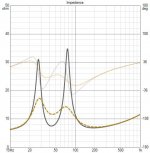a big box with a vent tuned high in frequency gives a very short vent even for a large diameter vent, do a vent need a certain length to work properly? 

I don't think so... I have seen older pro audio cabinets where the vent was just a hole cut into the cabinet. The length of the vent was the cabinet thickness (3/4 inch) and area of the hole was selected to create the correct Fb.
Not just pro-audio. I feel sure I've seen the respected Mission 727 with the port as a simple hole (in the front baffle).
Quite; it doesn't make any difference what the application environment is. For a given Vb, Fb, and vent CSA, the duct length (or lack thereof) simply is what it is. In practical terms there isn't a minimum per se other than in most cases whatever the build material thickness is, and to a point you can locally shave that down too, although from a structural POV that may not be a good plan.
that is what i have tried, basically a hole in the box, but the measured impedance curves looks wrong shaped, those twin impedance peaks looks very damped, so i guess this short vent alters the function in some way(s)
It doesn't, if it's calculated correctly -it's just a vent. You might want to double check the alignment & damping are in line with your measured T/S data for the same voltage drive & relevant series R from wire loop, passive series components etc. Sometimes a shift in voltage drive can do odd things, especially with units that have low mechanical resistance & tend to have greater changes as a result.
In theory there is no minimum vent lenght.
Even if its infinitely short, "end correction" gives certain effective lenght in relation to vent diameter/crossection. Thats beacuse air have to move fast around vent, so high acceleration makes it behave as mass.
Simple proof is beer can. If you blow on opening there will be some Helmholtz resonation despite "vent" is only fraction of a mm long.
Very short vent has very small friction resistance to air flow and that also might be the cause for unusual impedance measurings.
Even if its infinitely short, "end correction" gives certain effective lenght in relation to vent diameter/crossection. Thats beacuse air have to move fast around vent, so high acceleration makes it behave as mass.
Simple proof is beer can. If you blow on opening there will be some Helmholtz resonation despite "vent" is only fraction of a mm long.
Very short vent has very small friction resistance to air flow and that also might be the cause for unusual impedance measurings.
Looks like the box has some damping in it, perhaps more than optimum for reflex action.
It should be noted that all of the many Pensil designs Scott has done have vent length the same as box thickness (18-20mm)
dave
It should be noted that all of the many Pensil designs Scott has done have vent length the same as box thickness (18-20mm)
dave
Right, if one looks at the pioneer's reflex [simple hole] vented boxes there's very little damping, just a pad on the top, one side and back to maximize its output.
Experiments for your speaker.
1) Put your ear near the port and listen for midrange sound leakage.
2) What sounds better? Seal the port and listen for improved transients vs. open the port and listen for noticable bass extension.
Have you experimented with in-room speaker placement for smoother mid-bass and/or increased low bass SPL?
1) Put your ear near the port and listen for midrange sound leakage.
2) What sounds better? Seal the port and listen for improved transients vs. open the port and listen for noticable bass extension.
Have you experimented with in-room speaker placement for smoother mid-bass and/or increased low bass SPL?
- Home
- Loudspeakers
- Multi-Way
- very short vent
